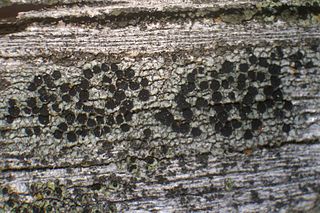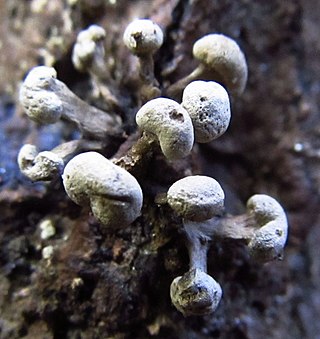
A hypha is a long, branching, filamentous structure of a fungus, oomycete, or actinobacterium. In most fungi, hyphae are the main mode of vegetative growth, and are collectively called a mycelium.
A hymenotomy is a medical procedure involving the surgical removal or opening of the hymen. It is often performed on patients with an imperforate or septate hymen, or other situations where the hymen is unusually thick or rigid such as microperforate hymen. In the case of a person with a hymen without any opening, an opening may be created in order to facilitate menstruation. In situations where the opening is extremely small or the band(s) of a septate hymen limit access to the vaginal opening, the individual may elect for hymenotomy to allow for comfortable sexual penetration of their vagina, or to relieve pain or discomfort that occurs when inserting/removing tampons. Sexual intercourse would not normally be adversely affected by a hymenotomy.
A uterine septum is a form of a congenital malformation where the uterine cavity is partitioned by a longitudinal septum; the outside of the uterus has a normal typical shape. The wedge-like partition may involve only the superior part of the cavity resulting in an incomplete septum or a subseptate uterus, or less frequently the total length of the cavity and the cervix resulting in a double cervix. The septation may also continue caudally into the vagina resulting in a "double vagina".

The Auriculariales are an order of fungi in the class Agaricomycetes. Species within the order were formerly referred to the "heterobasidiomycetes" or "jelly fungi", since many have gelatinous basidiocarps that produce spores on septate basidia. Around 200 species are known worldwide, placed in six or more families, though the status of these families is currently uncertain. All species in the Auriculariales are believed to be saprotrophic, most growing on dead wood. Fruit bodies of several Auricularia species are cultivated for food on a commercial scale, especially in China.

Buellia is a genus of mostly lichen-forming fungi in the family Caliciaceae. The fungi are usually part of a crustose lichen. In this case, the lichen species is given the same name as the fungus. But members may also grow as parasites on lichens (lichenicolous). The algae in the lichen is always a member of the genus Trebouxia.

Candelariaceae is a family of lichen-forming fungi in the order Candelariales. It contains seven genera and about 73 species. The family was circumscribed by Finnish lichenologist Rainar Hakulinen in 1954 to contain the type genus, Candelaria.

The Atractiellomycetes are class of fungi in the Pucciniomycotina subdivision of the Basidiomycota. The class consists of a single order, the Atractiellales, which contains 3 families, 10 genera, and 58 species.
The Cryptomycocolacomycetes are a class of fungi in the Pucciniomycotina subdivision of the Basidiomycota. The class contains a single order, the Cryptomycocolacales, which in turn contains the single family Cryptomycocolacaceae. The family has two monotypic genera.

The Microbotryomycetes are class of fungi in the Pucciniomycotina subdivision of the Basidiomycota. Until recently, the class contained four orders: the Heterogastridiales, the Leucosporidiales, the Microbotryales, and the Sporidiobolales, which contained a total of 4 families, 25 genera, and 208 species. The order Kriegeriales, containing two families, Kriegeriaceae and Camptobasidiaceae, was defined in 2012.

Pucciniomycetes is a diverse class of fungi in the subphylum Pucciniomycotina of phylum Basidiomycota. The class contains 5 orders, 21 families, 190 genera, and approximately 8,016 species. It has been estimated that this class contains about one third of all teleomorphic basidiomycetes. Pucciniomycetes contains many economically important plant pathogenic fungal rusts; the order Pucciniales is the largest clade in this class, representing approximately 7,000 species.
The Neogregarinorida are an order of parasitic alveolates in the phylum Apicomplexa. Species in this order infect insects and are usually found in the fat body, hemolymph, hypodermis, intestine or Malpighian tubules. The most common site of infection is the fat body: many species are pathogenic for their hosts.

Septate junctions are intercellular junctions found in invertebrate epithelial cells, appearing as ladder-like structures under electron microscopy. They are thought to provide structural strength and a barrier to solute diffusion through the intercellular space. They are considered somewhat analogous to the (vertebrate) tight junctions; however, tight and septate junctions are different in many ways. Known insect homologues of tight junction components are components of conserved signalling pathways that localize to either adherens junctions, the subapical complex, or the marginal zone. Recent studies show that septate junctions are also identified in the myelinated nerve fibers of the vertebrates.
The Eugregarinorida are the most large and diverse order of gregarines — parasitic protists belonging to the phylum Apicomplexa. Eugregarines are found in marine, freshwater and terrestrial habitats. These species possess large trophozoites that are significantly different in morphology and behavior from the sporozoites. This taxon contains most of the known gregarine species.
Dark septate endophytes (DSE) are a group of endophytic fungi characterized by their morphology of melanized, septate, hyphae. This group is likely paraphyletic, and contain conidial as well as sterile fungi that colonize roots intracellularly or intercellularly. Very little is known about the number of fungal taxa within this group, but all are in the Ascomycota. They are found in over 600 plant species and across 114 families of angiosperms and gymnosperms and co-occur with other types of mycorrhizal fungi. They have a wide global distribution and can be more abundant in stressed environments. Much of their taxonomy, physiology, and ecology are unknown.
Septatorina is a suborder of parasitic alveolates of the phylum Apicomplexa
Fusionidae is a family of the superfamily Fusionicae in the phylum Apicomplexa
Blabericolidae is a family of parasitic alveolates in the phylum Apicomplexia.
Porosporidae is a family of parasitic alveolates of the phylum Apicomplexia
Stylocephaloidea is a superfamily of parasitic alveolates of the phylum Apicomplexia
Stylocephaloidea is a superfamily of parasites of the phylum Apicomplexia.







